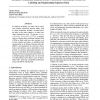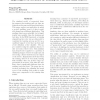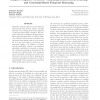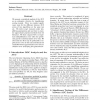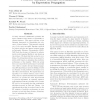123
click to vote
ICML
2004
IEEE
16 years 1 months ago
2004
IEEE
In sequence modeling, we often wish to represent complex interaction between labels, such as when performing multiple, cascaded labeling tasks on the same sequence, or when longra...
101
click to vote
ICML
2004
IEEE
16 years 1 months ago
2004
IEEE
lative Novelty to Identify Useful Temporal Abstractions in Reinforcement Learning ?Ozg?ur S?im?sek ozgur@cs.umass.edu Andrew G. Barto barto@cs.umass.edu Department of Computer Scie...
ICML
2004
IEEE
16 years 1 months ago
2004
IEEE
We describe and analyze an online algorithm for supervised learning of pseudo-metrics. The algorithm receives pairs of instances and predicts their similarity according to a pseud...
123
click to vote
ICML
2004
IEEE
16 years 1 months ago
2004
IEEE
The problem of computing low rank approximations of matrices is considered. The novel aspect of our approach is that the low rank approximations are on a collection of matrices. W...
106
click to vote
ICML
2004
IEEE
16 years 1 months ago
2004
IEEE
Many difficult visual perception problems, like 3D human motion estimation, can be formulated in terms of inference using complex generative models, defined over high-dimensional ...
90
Voted
ICML
2004
IEEE
16 years 1 months ago
2004
IEEE
The standard model of supervised learning assumes that training and test data are drawn from the same underlying distribution. This paper explores an application in which a second...
ICML
2004
IEEE
16 years 1 months ago
2004
IEEE
This paper extends previous work on the Skewing algorithm, a promising approach that allows greedy decision tree induction algorithms to handle problematic functions such as parit...
ICML
2004
IEEE
16 years 1 months ago
2004
IEEE
Reminder systems support people with impaired prospective memory and/or executive function, by providing them with reminders of their functional daily activities. We integrate tem...
ICML
2004
IEEE
16 years 1 months ago
2004
IEEE
101
click to vote
ICML
2004
IEEE
16 years 1 months ago
2004
IEEE
In many real-world classification problems the input contains a large number of potentially irrelevant features. This paper proposes a new Bayesian framework for determining the r...
